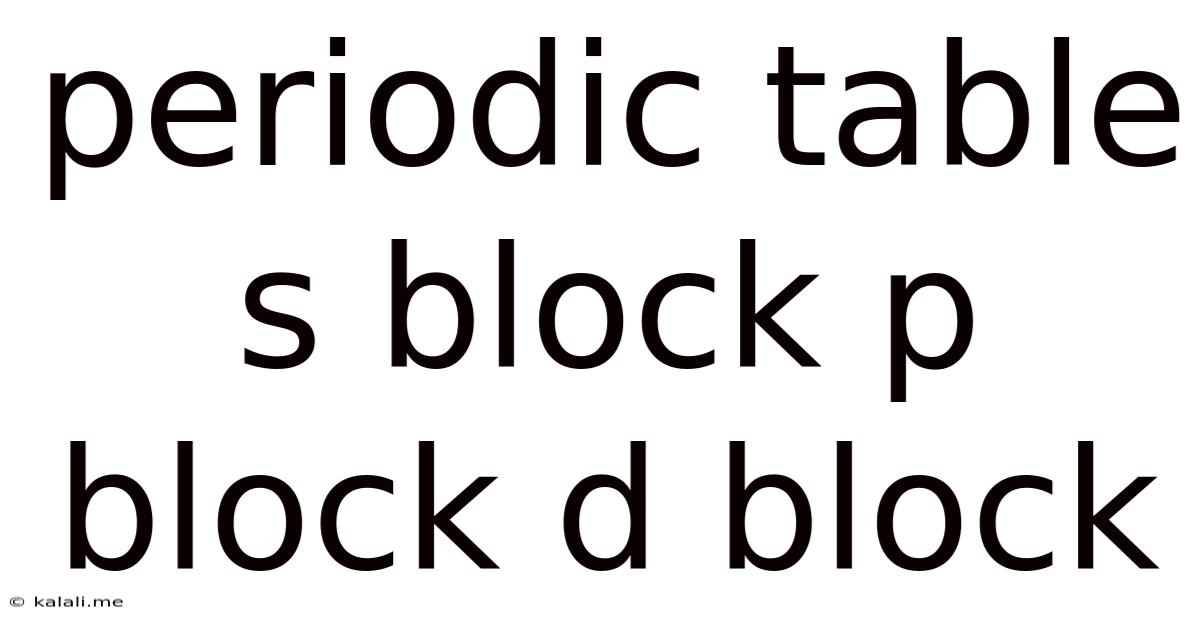Periodic Table S Block P Block D Block
Kalali
Jun 11, 2025 · 3 min read

Table of Contents
Understanding the s-block, p-block, and d-block elements of the Periodic Table
The periodic table is a cornerstone of chemistry, organizing elements based on their atomic structure and properties. This organization reveals fascinating trends and relationships between elements, and one key aspect of this organization is the division into blocks: the s-block, p-block, and d-block. Understanding these blocks is crucial for grasping the fundamental principles of chemistry. This article will delve into the characteristics, properties, and key elements within each block.
What are the s-block, p-block, and d-block elements? These classifications are based on the electronic configuration of the elements, specifically the subshell where the valence electrons (outermost electrons) reside. Valence electrons dictate an element's chemical behavior and reactivity.
The s-block elements: Alkali and Alkaline Earth Metals
The s-block occupies the first two groups of the periodic table. Its defining feature is that the valence electrons occupy the s subshell. This block comprises two groups:
-
Group 1: Alkali Metals (Li, Na, K, Rb, Cs, Fr): These are highly reactive metals with one valence electron. Their reactivity increases down the group. They readily lose this electron to form +1 ions, exhibiting low ionization energies and electronegativities. They are soft, have low melting and boiling points, and react vigorously with water.
-
Group 2: Alkaline Earth Metals (Be, Mg, Ca, Sr, Ba, Ra): These elements have two valence electrons in their s subshell. They are also reactive metals, though less so than alkali metals. They typically form +2 ions. Their properties are generally harder, denser, and have higher melting points compared to alkali metals.
The p-block elements: A Diverse Group
The p-block spans groups 13 to 18. The valence electrons occupy the p subshell. This block contains a vast array of elements showcasing diverse properties. It includes:
-
Metalloids: Elements exhibiting properties of both metals and nonmetals (e.g., Boron, Silicon, Germanium, Arsenic, Antimony, Tellurium). Their conductivity varies with temperature.
-
Nonmetals: Elements that lack metallic properties and are generally poor conductors of electricity and heat (e.g., Carbon, Nitrogen, Oxygen, Phosphorus, Sulfur, Chlorine, etc.). They exhibit high electronegativity and ionization energy.
-
Halogens (Group 17): Highly reactive nonmetals with seven valence electrons. They readily gain one electron to form -1 ions. Fluorine, Chlorine, Bromine, Iodine, and Astatine are examples.
-
Noble Gases (Group 18): Inert gases with a full complement of eight valence electrons (octet rule), making them exceptionally stable and unreactive. Helium, Neon, Argon, Krypton, Xenon, and Radon are examples.
The d-block elements: Transition Metals
The d-block occupies the middle section of the periodic table, encompassing groups 3 to 12. These elements are characterized by the filling of the d subshell. This block is known for:
-
Transition Metals: These elements exhibit variable oxidation states, meaning they can lose varying numbers of electrons to form ions with different charges. This contributes to their ability to form numerous colorful compounds and complex ions. They often act as catalysts in chemical reactions. Examples include Iron, Copper, Zinc, Nickel, and many more.
-
Properties: Transition metals generally exhibit high melting and boiling points, high density, and good electrical and thermal conductivity. Many are hard and strong.
In Summary:
The s-block, p-block, and d-block elements represent a fundamental classification system within the periodic table, reflecting the electronic configurations of their atoms. This organization allows us to understand and predict the chemical behavior and physical properties of elements, leading to a deeper appreciation of the periodic table's predictive power and the interconnectedness of chemical elements. Further exploration of each block reveals even more detailed trends and exceptions, making the study of the periodic table a continuously fascinating endeavor.
Latest Posts
Latest Posts
-
How Many 9s Are In A Deck Of Cards
Jul 01, 2025
-
How Many Pounds Are In 2 5 Kg
Jul 01, 2025
-
Which Is Greater 2 3 Or 2 4
Jul 01, 2025
-
How Do You Pass Level 7 On Bloxorz
Jul 01, 2025
-
If Your 13 What Year Were You Born
Jul 01, 2025
Related Post
Thank you for visiting our website which covers about Periodic Table S Block P Block D Block . We hope the information provided has been useful to you. Feel free to contact us if you have any questions or need further assistance. See you next time and don't miss to bookmark.